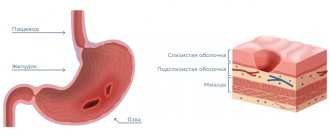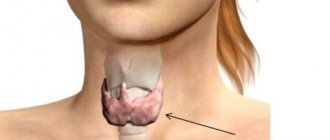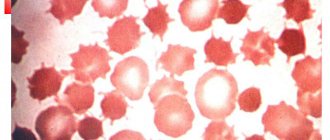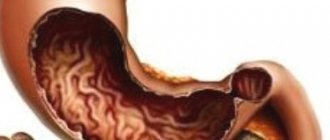Complexes with this research
Vegetarians and vegans Control of metabolism when refusing animal products RUB 3,560 Composition
Blue blood Assessment of iron deficiency and the effectiveness of the iron metabolic mechanism RUB 1,980 Composition
Advanced women's anti-aging diagnostics Advanced monitoring of basic blood parameters in women aged 40+ RUB 19,540 Composition
IN OTHER COMPLEXES
- Advanced male anti-aging diagnostics RUB 22,840
- Advanced anti-aging diagnostics in postmenopause RUB 19,860
- Male anti-aging diagnostics RUB 7,900
- Anti-aging diagnostics in postmenopause RUB 7,440
- Women's anti-aging diagnostics RUB 7,120
Preparing to donate blood
For this test, blood from a vein is taken on an empty stomach (food should not be consumed for 8 hours). During this period, only clean water is allowed; tea, coffee and carbonated drinks must be excluded. For half an hour before donating blood, you should avoid significant physical activity and stop smoking. Taking medications that contain iron should be stopped three days before the test (you should consult your doctor before stopping taking them).
Recommendations for preparation may be provided by the attending physician or laboratory staff.
General recommendations:
- avoiding drinks that contain sugar and caffeine;
- blood is donated on an empty stomach in the first half of the day (the fasting period should be 8-12 hours);
- It is recommended to quit smoking an hour before taking blood.
On the day of blood collection, you can only drink plain water (carbonated drinks, including those without sugar, should be excluded).
Detailed description of the study
Ferritin is a protein complex with iron ions. It is found in muscle, liver, spleen, bone marrow, reticulocytes (red blood cell precursor cells) and serum and is a form of iron reserve in the human body - one ferritin molecule can bind up to 4,000 iron atoms. When there is a lack of iron in the body, the ferritin reserve begins to be used. Thanks to this, the level of iron in the blood remains relatively constant.
A decrease in plasma ferritin levels serves as an indicator of iron deficiency and may indicate anemia (anemia). The most common manifestations of this condition are weakness and fatigue, drowsiness, pale skin, headache, dizziness, darkening of the eyes and tinnitus when changing body position.
The risk group for developing anemia includes:
- Women of childbearing age due to monthly blood loss;
- Pregnant women due to increased resource consumption of the body;
- Vegetarians and vegans due to insufficient intake of iron from food;
- People with gastrointestinal disorders due to iron malabsorption;
- Patients with chronic hemorrhoids;
- People over 65 years of age.
An increase in serum ferritin concentration can be observed in pathologies such as:
- Destruction of muscle tissue;
- Fractures of large bones;
- Extensive hematomas;
- Injuries to the spleen and inflammatory processes in it;
- Hematological diseases;
- Liver damage (viral hepatitis, liver necrosis);
- Kidney failure.
Determination of ferritin levels is used for the diagnosis and differential diagnosis of not only iron deficiency, but also the pathologies listed above.
Doctors from different countries note that patients with COVID-associated pneumonia are diagnosed with high levels of ferritin, which can reach 600 μg/L or higher. At the same time, there is a tendency to a slight decrease in indicators throughout the treatment period. Medvestnik asked the head of the Department of Clinical Hematology and Transfusiology of BelMAPO, Professor Lyudmila Smirnova, what a clinician needs to know about ferritin as a marker of the acute phase of inflammation.
Lyudmila Smirnova, Professor, Head of the Department of Clinical Hematology and Transfusiology BelMAPOWhat kind of protein is this?
Ferritin is synthesized by cells of various organs and tissues, primarily the liver, spleen, bone marrow, heart muscle, lungs, kidneys, thyroid gland, placenta, small intestine, pancreas, as well as leukocytes. Molecular weight 440 kDa. Ferritin accumulates and stores iron in the body in a non-toxic and bioavailable form.
It is localized predominantly intracellularly, but a small (strictly defined) amount of it is present in the blood plasma, which is determined in the laboratory as the “ferritin” indicator. The norm for women is 20–150 mcg/l (ng/ml), for men 40–300 mcg/l (ng/ml). Ferritin receptors are present on the membranes of normal and pathological cells. Secreted ferritin performs the following functions: regulation of myelopoiesis, lymphocyte migration, immunosuppressive function.
Marker of anemia and hyperferritinemia
The “serum ferritin” indicator is traditionally used as a marker of iron deficiency or excess in the body, as well as in monitoring the treatment of iron deficiency conditions. A serum ferritin level of less than 40 mcg/L is regarded as iron deficiency and indicates the presence of iron deficiency anemia. A serum ferritin level of more than 300 mcg/l (for men and women) is regarded as hyperferritinemia, which may be due to iron overload in the body (with prolonged frequent transfusions of red blood cells, hemochromatosis), as well as a sign of inflammation or tumor.
The correspondence between the level of serum ferritin (SF) and iron reserves in the body is lost during inflammatory processes, liver diseases, and tumors. In these cases, serum ferritin increases regardless of iron stores. An increase in ferritin levels is observed in COVID-associated pneumonia.
Connection with oncological processes
Ferritin can be regarded as a nonspecific cancer marker. With rapidly proliferating tumors, an increase in this indicator is observed. This hyperferritinemia does not reflect the metabolic processes of iron and its amount in the body.
Ferritin is also associated with increased apoptosis during anticancer therapy. The experiment showed that divalent metals, primarily iron, can be modifiers of apoptosis. This mechanism of hyperferritinemia is also possible during an infectious process before or during the period of convalescence.
It has been established that malignant tumors and chronic inflammation lead to a reduction in the transport (transferrin) pool of iron. In the presence of inflammation (tumor), low levels of iron in the serum are characteristic (the “serum iron” indicator drops), the concentration of transferrin is reduced with a high level of ferritin. Transferrin is a “negative” protein of the acute phase of inflammation, its level in plasma decreases.
Indicator of the acute phase of inflammation
An increase in ferritin levels is observed during acute inflammation, since ferritin acts as an acute-phase protein. During acute inflammation, the C-reactive protein (CRP) level increases significantly, but then usually its level decreases before the ferritin level, giving the so-called scissors: the ferritin level increases, and the CRP level decreases.
During treatment with positive dynamics, the CRP level decreases, the ferritin level may remain at the same high values or even increase. This is most likely due to the fact that CRP is synthesized mainly in the liver, and ferritin, in addition to the liver, is synthesized in the lungs and myocardium. As a result, in case of pneumonia or myocardial damage, ferritin will remain high.
Ferritin is associated with tumor necrosis factor alpha (TNF-α), which is released by certain cells as a result of exposure to a variety of stimuli: viruses, ultraviolet radiation, interleukins (including IL-6), and oxidative stress. These facts suggest that, due to its unique biochemical properties, ferritin is at the center of several regulatory mechanisms involved in a wide range of metabolic processes during inflammation.
For example, the level of ferritin increases during the period of infection with the human immunodeficiency virus; it is this period that corresponds to maximum lymphoid activation (the number of T-helper cells increases), and lymphadenopathy is characteristic.
Against the background of an acute infectious process, so-called anemia of a chronic disease (D-63 according to ICD-10) can develop, including anemia of inflammation. This type of anemia is characterized by a decrease in serum iron against the background of increased ferritin. In a general blood test, such anemia is characterized by low MCV and MCH values, that is, it is microcytic and hypochromic. Reminds me of iron deficiency anemia. Iron supplements should not be prescribed, since this is anemia of a chronic disease, characterized by normal and even increased iron reserves in macrophages, against the background of high levels of pro-inflammatory cytokines (IL-6, TNF-α, etc.). After relief of pneumonia, anemia of moderate severity (more than 70 g/l) may persist for some time, this indicates that the inflammation process is not completed (ferritin is high, CRP is slightly increased). The hemoglobin level normalizes with complete relief of inflammation.
Transfusions of erythrocyte-containing media are indicated when hemoglobin levels are less than 70 g/l. However, it is necessary to take into account not only the hemoglobin level, but also the general condition of the patient, hemodynamic changes caused by the individual response to anemic hypoxia.
Growth in multiple organ failure
The reason for the increase in serum ferritin in various types of liver pathology (severe hepatitis, cancer, cirrhosis) is associated with the process of ferritin release from hepatocytes during their destruction. In liver pathology, ferritin levels also increase against the background of a parallel increase in the levels of AST and ALT. In case of multiple organ failure, one should expect very high levels of ferritin due to its release from hepatocytes, myocardial tissue, and lungs.
Summary
Thus, during the inflammatory process, including COVID-associated pneumonia, the ferritin level rises to more than 300 µg/l, sometimes reaching a level of more than 1,000 µg/l; transferrin decreases (less than 2 g/l), serum iron is below normal (less than 11 µmol/l). The CRP level increases significantly, in parallel or ahead of the ferritin level for several days.
The fibrinogen level increases by more than 4 g/l, reaching values of more than 10 g/l.
During treatment with positive dynamics: the CRP level decreases, the ferritin level may remain at the same high values or even increase slightly. With pneumonia or myocardial damage, ferritin will remain high, and with liver pathology, an increase in ferritin is combined with increased levels of AST and ALT.
Upon recovery, all markers of the acute phase of inflammation return to normal values.
The use of several inflammatory markers allows for more adequate and complete monitoring of the pathological process.
Interpretation of results
Blood test for ferritin
used to diagnose anemia caused by infectious diseases, the development of a malignant neoplasm or an inflammatory process. It is also prescribed when differential diagnosis of iron deficiency anemia is necessary. Reference values differ depending on gender. For women they are 10-150 ng/mg, and for men 20-350 ng/mg. If acute inflammation develops in the body, ferritin concentration increases significantly. A slight decrease in its amount in pregnant women is within normal limits and does not indicate the presence of pathology. Iron deficiency anemia is characterized by a lack of ferritin.
An increase in indicators is possible in the following cases:
- liver pathologies;
- acute inflammatory process;
- lymphogranulomatosis;
- leukemia;
- long-term use of oral contraceptives;
- general exhaustion of the body.
This test is not intended for self-diagnosis and should only be interpreted by a physician. Self-medication can cause irreparable harm to your health, so you should not risk it; you should consult a doctor. When interpreting the results, data from other studies, individual characteristics of the organism and a number of other factors are taken into account. If deviations from the norm are detected in the early stages, in many cases, taking a course of a vitamin-mineral complex is sufficient to normalize them, but such a drug must be prescribed by a doctor. For the most reliable assessment of iron metabolism, as a rule, a complex of laboratory tests is carried out, rather than a single analysis.
Still have questions? Contact us:
What happens when there is low acidity in the stomach?
Low acidity in the stomach leads to poor protein breakdown. Trivalent iron does not convert into divalent iron, and, entering the intestines unchanged, is poorly absorbed. Low acidity reduces the production of intrinsic factor in the stomach. This is a protein that converts vitamin B12 into an absorbable form and transports it to the intestines. With low acidity, vitamin B9 (folic acid) is almost completely destroyed, and it is necessary for the synthesis of amino acids and the absorption of vitamin B12.
What affects the production of hydrochloric acid?
The key stimulators of the production of gastric juice - hydrochloric acid - are histamine, acetylcholine and gastrin. Gastrin has the greatest effect. It is produced by endocrines - G-cells. The production of gastrin depends on somatostatin, a hormone produced by the pancreas and hypothalamus. Somatostatin suppresses gastrin production. The secretion of digestive enzymes and bile is disrupted, and acidity decreases.
The function of the hypothalamus is closely related to the function of the thyroid gland and pituitary gland. If there is a violation, protein from food will not be absorbed.
Integrated approach: ferritin, hormones, iron, folic acid, TSH
For effective treatment, in addition to ferritin levels, it is necessary to check hormonal levels, serum iron levels, vitamins B12 and B9 (folic acid). If the level of iron and vitamins B12 and B9 is low, protein supplements alone will not be able to increase ferritin levels. The problem must be solved as a whole. It is worth noting that the levels of copper, calcium, and vitamin C do not play
.









